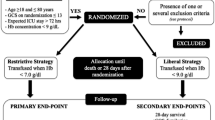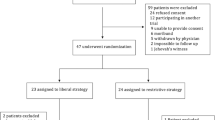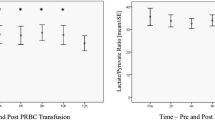Abstract
Background
Red blood cell (RBC) transfusion is associated with inconsistent changes in brain tissue oxygenation (PbO2). Previous studies have failed to consider alterations in cerebral autoregulation. Our objective was to investigate the effect of RBC transfusion on cerebral autoregulation, as measured by pressure reactivity index (PRx).
Methods
Retrospective analysis of 28 severe traumatic brain injury (TBI) patients from a prospective registry between 2007 and 2014. We recorded hemoglobin (Hb) concentration, intracranial pressure, PbO2, cerebral perfusion pressure, PRx, and cerebral lactate/pyruvate ratio for 6 h before and after RBC transfusion. We also recorded body temperature, PaO2, PCO2, pH, and fraction of inspired oxygen. Subgroups of normoxia (PbO2 >20 mmHg) and hypoxia (PbO2 <20 mmHg) prior to transfusion were defined a priori.
Results
The median age was 36 years [interquartile range (IQR) 27–49], 32 % were female. The median admission Glasgow Coma score was 5 (IQR 4–9) and injury severity score was 16 (IQR 9–21). Overall, mean Hb concentration [80 g/L (SD 7) to 89 g/L (SD 8), p < 0.001] and PbO2 increased [23.5 mmHg (SD 8) to 25.0 mmHg (SD 9), p = 0.033] following transfusion. PRx increased post-transfusion [0.028 (SD 0.29) to 0.11 (SD 0.24), p = 0.034], indicating worsening cerebrovascular pressure reactivity. In patients with mean PbO2 >20 mmHg pre-transfusion (n = 20), the PRx increased significantly [−0.052 (SD 0.24) to 0.079 (SD 0.22), p = 0.007] but did not change in patients with PbO2 <20 mmHg: PRx [0.22 (SD 0.34) to 0.18 (SD 0.30), p = 0.36].
Conclusion
RBC transfusion in severe TBI patients results in worsening PRx, indicating impaired cerebral autoregulation.

Similar content being viewed by others
References
Foundation BT, Surgeons AA of N, Surgeons C of N, Joint Section on Neurotrauma and Critical Care A, Bratton SL, Chestnut RM, et al. Guidelines for the management of severe traumatic brain injury I. Blood pressure and oxygenation. J Neurotrauma. 2007;24(Suppl 1):S7–13.
Chesnut RM, Marshall LF, Klauber MR, Blunt BA, Baldwin N, Eisenberg HM, et al. The role of secondary brain injury in determining outcome from severe head injury. J Trauma. 1993;34:216–22.
Bratton SL, Chestnut RM, Ghajar J, McConnell Hammond FF, Harris OA, Hartl R, et al. Guidelines for the management of severe traumatic brain injury I. Blood pressure and oxygenation. J Neurotrauma. 2007;24(Suppl 1):S7–13.
Chesnut RM, Temkin N, Carney N, Dikmen S, Rondina C, Videtta W, et al. A trial of intracranial-pressure monitoring in traumatic brain injury. N Engl J Med. 2012;367:2471–81.
Jones PA, Andrews PJ, Midgley S, Anderson SI, Piper IR, Tocher JL, et al. Measuring the burden of secondary insults in head-injured patients during intensive care. J Neurosurg Anesthesiol. 1994;6:4–14.
Sekhon MS, McLean N, Henderson WR, Chittock DR, Griesdale DE. Association of hemoglobin concentration and mortality in critically ill patients with severe traumatic brain injury. Crit Care. 2012;16:R128.
Zygun DA, Nortje J, Hutchinson PJ, Timofeev I, Menon DK, Gupta AK. The effect of red blood cell transfusion on cerebral oxygenation and metabolism after severe traumatic brain injury. Crit Care Med. 2009;37:1074–8.
Smith MJ, Stiefel MF, Magge S, Frangos S, Bloom S, Gracias V, et al. Packed red blood cell transfusion increases local cerebral oxygenation. Crit Care Med. 2005;33:1104–8.
Leal-Noval SR, Rincón-Ferrari MD, Marin-Niebla A, Cayuela A, Arellano-Orden V, Marín-Caballos A, et al. Transfusion of erythrocyte concentrates produces a variable increment on cerebral oxygenation in patients with severe traumatic brain injury: a preliminary study. Intensive Care Med. 2006;32:1733–40.
Hébert PC, Wells G, Blajchman MA, Marshall J, Martin C, Pagliarello G, et al. A multicenter, randomized, controlled clinical trial of transfusion requirements in critical care. Transfusion requirements in critical care investigators, Canadian Critical Care Trials Group. N Engl J Med. 1999;340:409–17.
McIntyre LA, Fergusson DA, Hutchison JS, Pagliarello G, Marshall JC, Yetisir E, et al. Effect of a liberal versus restrictive transfusion strategy on mortality in patients with moderate to severe head injury. Neurocrit Care. 2006;5:4–9.
Corwin HL, Gettinger A, Pearl RG, Fink MP, Levy MM, Abraham E, et al. The CRIT study: anemia and blood transfusion in the critically ill–current clinical practice in the United States. Crit Care Med. 2004;32:39–52.
Hare GMT, Mazer CD, Hutchison JS, McLaren AT, Liu E, Rassouli A, et al. Severe hemodilutional anemia increases cerebral tissue injury following acute neurotrauma. J Appl Physiol. 2007;103:1021–9.
Utter GH, Shahlaie K, Zwienenberg-Lee M, Muizelaar JP. Anemia in the setting of traumatic brain injury: the arguments for and against liberal transfusion. J Neurotrauma. 2011;28:155–65.
LeRoux P. Haemoglobin management in acute brain injury. Curr Opin Crit Care. 2013;19:83–91.
Sekhon MS, McBeth P, Zou J, Qiao L, Kolmodin L, Henderson WR, et al. Association between optic nerve sheath diameter and mortality in patients with severe traumatic brain injury. Neurocrit Care. 2014;21:245–52.
Oddo M, Levine JM, Kumar M, Iglesias K, Frangos S, Maloney-Wilensky E, et al. Anemia and brain oxygen after severe traumatic brain injury. Intensive Care Med. 2012;38:1497–504.
Salim A, Hadjizacharia P, DuBose J, Brown C, Inaba K, Chan L, et al. Role of anemia in traumatic brain injury. J Am Coll Surg. 2008;207:398–406.
Carlson AP, Schermer CR, Lu SW. Retrospective evaluation of anemia and transfusion in traumatic brain injury. J Trauma. 2006;61:567–71.
Robertson CS, Hannay HJ, Yamal J-M, Gopinath S, Goodman JC, Tilley BC, et al. Effect of erythropoietin and transfusion threshold on neurological recovery after traumatic brain injury. JAMA. 2014;312:36.
Steiner LA, Czosnyka M, Piechnik SK, Smielewski P, Chatfield D, Menon DK, et al. Continuous monitoring of cerebrovascular pressure reactivity allows determination of optimal cerebral perfusion pressure in patients with traumatic brain injury. Crit Care Med. 2002;30:733–8.
Aries MJH, Czosnyka M, Budohoski KP, Steiner LA, Lavinio A, Kolias AG, et al. Continuous determination of optimal cerebral perfusion pressure in traumatic brain injury. Crit Care Med. 2012;40:2456–63.
Czosnyka M, Smielewski P, Lavinio A, Czosnyka Z, Pickard JD. A synopsis of brain pressures: which? when? are they all useful? Neurol Res. 2007;29(7):672–9.
Jaeger M, Dengl M, Meixensberger J, Schuhmann MU. Effects of cerebrovascular pressure reactivity-guided optimization of cerebral perfusion pressure on brain tissue oxygenation after traumatic brain injury. Crit Care Med. 2010;38(5):1343–7.
Aries MJ, Czosnyka M, Budohoski KP, Steiner LA, Lavinio A, Kolias AG, Hutchinson PJ, et al. Continuous determination of optimal cerebral perfusion pressure in traumatic brain injury. Crit Care Med. 2012;40(8):2456–63.
Patel HC, Menon DK, Tebbs S, Hawker R, Hutchinson PJ, Kirkpatrick PJ. Specialist neurocritical care and outcome from head injury. Intensive Care Med. 2002;28:547–53.
Steiner LA, Coles JP, Johnston AJ, Chatfield DA, Smielewski P, Fryer TD, et al. Assessment of cerebrovascular autoregulation in head-injured patients: a validation study. Stroke. 2003;34:2404–9.
Johnston AJ, Steiner LA, Coles JP, Chatfield DA, Fryer TD, Smielewski P, et al. Effect of cerebral perfusion pressure augmentation on regional oxygenation and metabolism after head injury. Crit Care Med. 2005;33:189–95 discussion 255–7.
Jaeger M, Schuhmann MU, Soehle M, Meixensberger J. Continuous assessment of cerebrovascular autoregulation after traumatic brain injury using brain tissue oxygen pressure reactivity. Crit Care Med. 2006;34:1783–8.
Bisschops LLA, Pop GAM, Teerenstra S, Struijk PC, van der Hoeven JG, Hoedemaekers CWE. Effects of viscosity on cerebral blood flow after cardiac arrest. Crit Care Med. 2014;42:632–7.
Sriram K, Salazar Vázquez BY, Tsai AG, Cabrales P, Intaglietta M, Tartakovsky DM. Autoregulation and mechanotransduction control the arteriolar response to small changes in hematocrit. Am J Physiol Heart Circ Physiol. 2012;303:H1096–106.
Weinberg JA, Barnum SR, Patel RP. Red blood cell age and potentiation of transfusion-related pathology in trauma patients. Transfusion. 2011;51:867–73.
Neuman R, Hayek S, Rahman A, Poole JC, Menon V, Sher S, et al. Effects of storage-aged red blood cell transfusions on endothelial function in hospitalized patients. Transfusion. 2014;. doi:10.1111/trf.12919.
Leal-Noval SR, Muñoz-Gómez M, Arellano-Orden V, Marín-Caballos A, Amaya-Villar R, Marín A, et al. Impact of age of transfused blood on cerebral oxygenation in male patients with severe traumatic brain injury. Crit Care Med. 2008;36:1290–6.
Kramer AH, Zygun DA. Anemia and red blood cell transfusion in neurocritical care. Crit Care. 2009;13:R89.
Acknowledgments
We would like to acknowledge the Addenbrooke’s neurocritical care unit staff for their assistance. Additionally, we would like to acknowledge Mrs. Karyn McMurray from the Addenbrooke’s blood services for her assistance in patient identification.
Conflict of interest
Mypinder S. Sekhon, Donald E. Griesdale, Joseph Donnelly, Xia Liu, Marcel J. Aries, Chiara Robba, Andrea Lavinio, David K. Menon, Peter Smielewski, Arun K. Gupta have no conflict of interest. Marek Czosnyka and Peter Smielewski are co-founders of the ICM+ software (www.neurosurg.cam.ac.uk/icmplus) and receives licensing fees (Cambridge Enterprise Ltd, UK).
Ethical standards
All human and animal studies have been approved by the appropriate ethics committee and have therefore been performed in accordance with the ethical standards laid down in the 1964 Declaration of Helsinki and its later amendments.
Author information
Authors and Affiliations
Corresponding author
Additional information
Drs Gupta and Smielewski are denoted as co-senior authors for this manuscript.
Rights and permissions
About this article
Cite this article
Sekhon, M.S., Griesdale, D.E., Czosnyka, M. et al. The Effect of Red Blood Cell Transfusion on Cerebral Autoregulation in Patients with Severe Traumatic Brain Injury. Neurocrit Care 23, 210–216 (2015). https://doi.org/10.1007/s12028-015-0141-x
Published:
Issue Date:
DOI: https://doi.org/10.1007/s12028-015-0141-x




